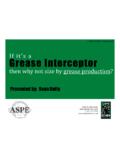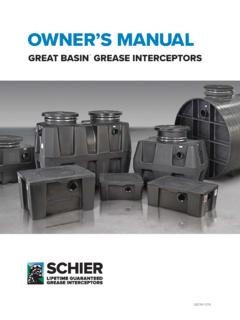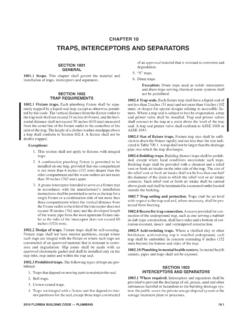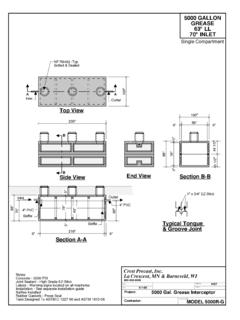Transcription of Conveyance Systems - ndwrcdp.org
1 Co-published byAssessment of grease interceptor Performance(Supplemental Report to 03-CTS-16T) Conveyance 9/29/08 11:36 AM Page 1 (2,1) ASSESSMENT OF grease interceptor PERFORMANCE Supplemental Report to 03-CTS-16T by: Joel J. Ducoste North Carolina State University Kevin M. Keener Purdue University John W. Groninger Southern Illinois University Leon M. Holt Town of Cary 2008 03-CTS-16TA ii The Water Environment Research Foundation, a not-for-profit organization, funds and manages water quality research for its subscribers through a diverse public-private partnership between municipal utilities, corporations, academia, industry, and the federal government. WERF subscribers include municipal and regional water and wastewater utilities, industrial corporations, environmental engineering firms, and others that share a commitment to cost-effective water quality solutions. WERF is dedicated to advancing science and technology addressing water quality issues as they impact water resources, the atmosphere, the lands, and quality of life.
2 For more information, contact: Water Environment Research Foundation 635 Slaters Lane, Suite 300 Alexandria, VA 22314-1177 Tel: (703) 684-2470 Fax: (703) 299-0742 This report was co-published by the following organization. For non-subscriber sales information, contact: IWA Publishing Alliance House, 12 Caxton Street London SW1H 0QS, United Kingdom Tel: +44 (0) 20 7654 5500 Fax: +44 (0) 20 7654 5555 Copyright 2008 by the Water Environment Research Foundation. All rights reserved. Permission to copy must be obtained from the Water Environment Research Foundation. Library of Congress Catalog Card Number: 2008934928 Printed in the United States of America IWAP ISBN: 978-1-84339-526-3/1-84339-526-6 This report was prepared by the organization(s) named below as an account of work sponsored by the Water Environment Research Foundation (WERF). Neither WERF, members of WERF, the organization(s) named below, nor any person acting on their behalf: (a) makes any warranty, express or implied, with respect to the use of any information, apparatus, method, or process disclosed in this report or that such use may not infringe on privately owned rights; or (b) assumes any liabilities with respect to the use of, or for damages resulting from the use of, any information, apparatus, method, or process disclosed in this report.
3 North Carolina State University This document was reviewed by a panel of independent experts selected by WERF. Mention of trade names or commercial products does not constitute WERF nor endorsement or recommendations for use. Similarly, omission of products or trade names indicates nothing concerning WERF's positions regarding product effectiveness or applicability. Assessment of grease interceptor Performance iii The authors of this report are indebted to the following water utilities, companies, and individuals for their cooperation and participation in this project: Town of Cary, North Carolina Oxford Tobacco Research Station, North Carolina Carolina Classic Manufacturing, Inc. Wilkes Enterprise, Inc Duke Roots, Inc. RootX Root Control Corp. Solutions-IES Research performed at North Carolina State University could not have been accomplished without the help of students and lab technicians. Tarek Aziz, a candidate at the time of this research, was responsible for a significant portion of the lab work and modeling work, and construction of piping network and instrumentation for the pilot system displayed in this document.
4 Mr. Steve Wade, the civil engineering lab technician, constructed the frame for the lab-scale grease interceptor . The principal investigators (PIs) are also indebted to Mr. Lorenzo Watson, the civil engineering IT person, for maintaining the stability of the computer hardware. The principal investigators would like to thank Sandy Rantoul from Wilkes Enterprise, Inc. for donating the Infracal instrument to perform FOG measurements and John Eason from Carolina Classic Manufacturing for the construction of the pilot grease interceptor . The PIs would also like to thank Donald Smith, Mark Lovitt, and Perry Joyner from the Town of Cary for their support of field measurements and consequent lab experiments for analysis of grease interceptor performance. Report Preparation Principal Investigators: Joel J. Ducoste, , North Carolina State University Kevin M. Keener, , Purdue University John W. Groninger, , Southern Illinois University Project Subcommittee Mary Lappin, RC Liaison, Kansas City Water Services Department Mark Kawamoto, PSC Chair, Orange County Sanitation District Philip Friess, County Sanitation Districts of Los Angles County Gayle Tupper, East Bay Municipal Utility District Kevin Sherman, Florida Onsite Wastewater Association Hugh T.
5 Garrison, Metro Water Services, Nashville Charles Vanderlyn, , EPA ACKNOWLEDGEMENTS iv Steering Subcommittee Frank Brockman, Cobb County Ben Horenstien, East Bay Municipal Utilities District Mike Dunbar, South Coast Water District John Redner, PE, County Sanitation Districts of Los Angles County Jim Peters, PE, DEE, Florida Water Environment Association Utility Council Quyen Tram, PE, Toho Water Authority Brian Wheeler, Toho Water Authority Nick Arhontes, PE Orange County Sanitation District Terrie Mitchell, Sacramento Regional County Sanitation District Drew Mihocko, City of Philadelphia Water Department Tim McKim, PE, Reedy Creek Energy Services Adel Hagekhalil, City of Los Angeles Christine Mikulice, County of San Francisco Water Pollution Control Gail Chester, , PE, Central Contra Costa Sanitary District Brett Goodman, Gainesville Regional Utility Rick Oliver, Jensen Precast Water Environment Research Foundation Director of Research Daniel M.
6 Woltering, Senior Program Director: Amit Pramanik, , BCEEM Program Director: Lauren Fillmore Program Manager: Jane Casteline Assessment of grease interceptor Performance v Abstract: Fat, oil, and grease (FOG) is generated everyday by food preparation and cleaning activities conducted at commercial establishments and, on a smaller scale, by residential sewer usage. FOG accumulations in the sanitary sewer collection system result in reduced capacity that may lead to sanitary sewer overflows (SSO) if not periodically removed. The primary means of controlling FOG blockages is to capture and retain FOG materials before discharge into sewer Systems through the use of passive grease interception devices. Limited scientific studies have evaluated the performance of these devices. Many claims of enhanced performance made by manufacturers of grease and oil interception devices need to be verified by objective and unbiased research protocols.
7 This report presents the evaluation of field grease interceptors through their separation and cleaning cycles. In addition, researchers performed controlled laboratory scale grease interceptor tests and numerical simulations to assess removal efficiency by grease interceptors (GI) at different residence times and under different geometric configurations Numerical simulations included a 3-D multi-phase flow model of a grease interceptor to evaluate design changes, and operation and maintenance conditions on the removal of FOG from foodservice waste streams. The results from experimental tests performed on lab-scale grease interceptors were used to validate the model results. Benefits: Determines the optimal design, sizing, and operations and maintenance criteria for grease interceptors to help control problems with FOG in centralized and decentralized Systems . Develops an alternative design methodology for grease interceptors that can be submitted to the International Association of Plumbing & Mechanical Officials (IAPMO) for consideration for inclusion into the Uniform Plumbing Code (UPC).
8 Keywords: Fats, oils, grease , FOG, grease interceptors, residence time, scouring, accumulation, performance, percent removal, globule, droplet AND BENEFITS vi Acknowledgements .. iii Abstract and Benefits ..v List of Tables .. viii List of Figures .. ix Executive Summary ..ES-1 Introduction .. 1-1 Background .. 1-1 Significance to Waste Water Utilities .. 1-2 Literature 1-2 Research Scope and Objectives .. 1-5 Material and Methods .. 2-1 Field Measurements of grease Interceptors .. 2-1 Assessment of FOG and Solids Profile in Field grease Interceptors .. 2-1 Pilot Scale grease interceptor .. 2-2 Bench Scale grease interceptor .. 2-6 Experimental Tests on Impact of Influent Temperature .. 2-6 Analysis of FOG Concentration Using Infracal Device .. 2-7 Analysis of FOG Concentration using EPA Method 1664 .. 2-8 Numerical Methods .. 3-1 Flow Field and Turbulence 3-1 Numerical Simulation Setup.
9 3-3 Algebraic Slip Model .. 3-3 Numerical Tracer Test Model .. 3-4 Field Assessment of grease interceptor Performance .. 4-1 Food Waste Solids Characterization .. 4-1 grease interceptor Influent Solids and Particle Analysis .. 4-3 grease interceptor Influent Fluid Flow 4-5 FOG Concentration Assessment from Field grease interceptor .. 4-13 Analysis of pH and Dissolved Oxygen in Field grease interceptor .. 4-14 FOG and Solids Accumulation Analysis .. 4-17 Assessment of Food Service Establishment grease interceptor without Food Grinder .. 4-20 Assessment of Food Service Establishment grease interceptor with Food Grinder .. 4-25 Summary of Field Assessment of grease Interceptors .. 4-28 Experimental and Numerical Assessment of grease interceptor Performance .. 5-1 Introduction .. 5-1 Experimental Assessment .. 5-1 TABLE OF CONTENTS Assessment of grease interceptor Performance vii Bench Experimental Tests.
10 5-5 Pilot Experimental Tests .. 5-11 Numerical Assessment .. 5-12 Summary of Numerical and Experimental GI tests .. 5-31 Analysis of Simulated Tracer Tests .. 5-32 Conclusions and Recommendations .. 6-1 Conclusions .. 6-1 Future Research Considerations .. 6-2 References ..R-1 viii 1-1 grease interceptor Effluent Measurements (Lesikar et al., 2006).. 1-3 1-2 Surveyed Variables Tested with MRBE and RMASE (Garza et al., 2005) .. 1-4 4-1 Results of Particle Analysis from Full Fare Buffet Style grease interceptor ( Part 1) .. 4-4 4-2 Results of Particle Analysis from Full Fare Buffet Style grease interceptor (Part 2) .. 4-5 4-3 Flow Data from grease interceptor Influent from Different Restaurant Types .. 4-8 4-4 Total Oil and grease Measurements at Clark Dining Hall, Day 1 (1/11/06) .. 4-13 4-5 Total Oil and grease Measurements at Clark Dining Hall, Day 2 (1/19/06) .. 4-13 4-6 Influent and Effluent pH Values at Various Times.







